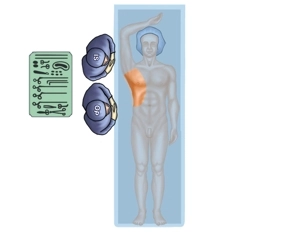Postoperative analgesia: Nonsteroidal anti-inflammatory drugs usually suffice; if necessary, they can be enhanced by opioid analgesics.
Follow this link to PROSPECT (Procedures Specific Postoperative Pain Management)
This link will take you to the International Guideline Library.
Monitoring of the tube: In correctly inserted chest tubes the water level in the collection chamber moves synchronously with the patient’s ; air escapes when a pneumothorax is being decompressed. Persistent “bubbling” in the collection chamber indicates either a continued air leak or an improperly attached connector in the tube system. If in persistent air leaks the tube suddenly stops collecting air , tube occlusion, which would result in tension pneumothorax, must be ruled out (lavage with bladder syringe + NaCl 0.9% as an emergency measure).
While blood clots may repeatedly block the tube, this can often be resolved by milking out the tubing toward the collection chamber.
Postoperative care: Varies depending on the indication:
in pneumothorax:
Leave the chest tube under suction (15-20 mmHg) for 3-5 days, then remove the suction and take a follow-up radiograph; if no pneumothorax is evident: Disconnect for 4 hours and repeat the chest radiograph
If radiographic findings are negative: Remove the chest tube.
If the radiographic findings are positive, leave the suction in place for 12 hours and repeat the suction removal.
In case of persistent pneumothorax: Surgical or thoracoscopic pleurodesis or pleural abrasion.
in hemothorax:
Drainage volume >1200 mL per day: Stop the source of bleeding surgically
Drainage volume <100 mL/day: Remove the chest tube. After removing the tube always take a chest radiograph!
Tube removal:
Careful disinfection, then U-stitch suture around the tube (e.g., Mersilene 2-0). Preplace the knot and hold the suture ends under tension. The tube is removed by a second person while the patient exhales. Simultaneously tighten the knot while closely apposing the edges of the wound and apply a sterile dressing.
Deep venous thrombosis prophylaxis: Depending on the disease; administration of low-dose heparin is quite enough in active young patients with a spontaneous pneumothorax.
Note: Renal function, HIT II (history, platelet check)
This link will take you to the International Guideline Library.
Ambulation: Immediately; ensure adequate analgesia to avoid shallow breathing
Physical therapy: Breathing exercises in elderly patients to prevent pneumonia.


